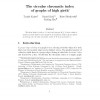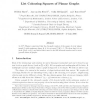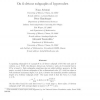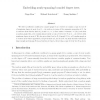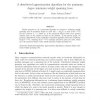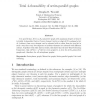94
Voted
JGT
2007
15 years 13 days ago
2007
: Let G be a graph with maximum degree d ≥ 3 and ω(G) ≤ d, where ω(G) is the clique number of the graph G. Let p1 and p2 be two positive integers such that d = p1 + p2. In th...
93
Voted
JCT
2007
15 years 13 days ago
2007
We show that for each ε > 0 and each integer ∆ ≥ 1, there exists a number g such that for any graph G of maximum degree ∆ and girth at least g, the circular chromatic in...
88
Voted
ENDM
2007
15 years 15 days ago
2007
In 1977, Wegner conjectured that the chromatic number of the square of every planar graph G with maximum degree ∆ ≥ 8 is at most 3
90
Voted
JGT
2008
15 years 15 days ago
2008
A spanning subgraph G of a graph H is a k-detour subgraph of H if for each pair of vertices x, y V (H), the distance, distG(x, y), between x and y in G exceeds that in H by at mo...
104
Voted
COMBINATORICA
2007
15 years 16 days ago
2007
We derive a sufficient condition for a sparse graph G on n vertices to contain a copy of a tree T of maximum degree at most d on (1 − )n vertices, in terms of the expansion prop...
104
click to vote
DM
2006
15 years 17 days ago
2006
An L(h, k)-labeling of a graph G is an integer labeling of vertices of G, such that adjacent vertices have labels which differ by at least h, and vertices at distance two have lab...
114
Voted
CORR
2006
Springer
15 years 17 days ago
2006
Springer
Fischer proposes in [4] a sequential algorithm to compute a minimum weight spanning tree of maximum degree at most b + logb n in time O n4+1/ln b for any constant b > 1, where ...
97
Voted
COMBINATORICS
2006
15 years 17 days ago
2006
It is proved that, if G is a K4-minor-free graph with maximum degree 3, then G is totally 4-choosable; that is, if every element (vertex or edge) of G is assigned a list of 4 colo...
COMBINATORICS
2006
15 years 17 days ago
2006
It is proved that, if G is a K4-minor-free graph with maximum degree 4, then G is totally ( + 1)-choosable; that is, if every element (vertex or edge) of G is assigned a list of ...

